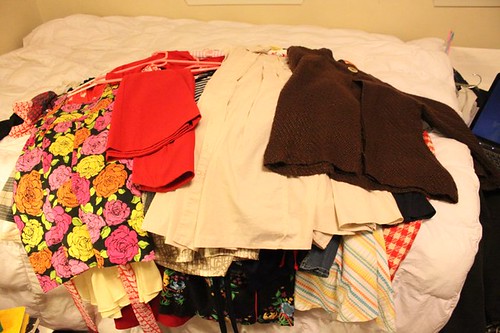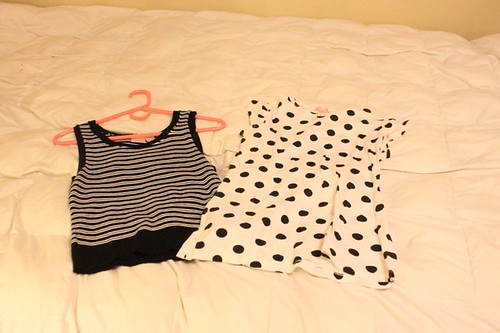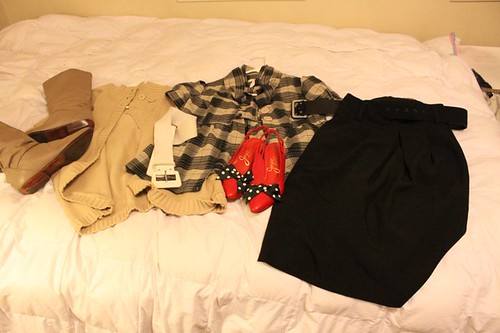As consumers, we have a lot to think about when purchasing clothes, shoes, purses, and accessories. Things like style, color, fit, and price seem to be the most important factors when choosing an item to purchase. But, as we all know but seldom think about, is the impact we make when we purchase something. The impact we make on the sales and profits of whatever store or site we're buying from, sure, but also the economic, environmental, and social impact we make as well, things like the material (organic, renewable sources, recycled material, etc) and the process in which the garment was made (factory environment, child labor, fair trade, etc) should also be put into consideration when buying a product.
I read this great post last night from
39th and Broadway about the
label of origin on garments, and it really got me thinking. The label of origin is the tag that states where the garment was made. If you ever wonder how companies can sell things for so cheap, look at the tag, it was probably made in a developing country where the standard of living is low and there are no laws against child labor or fair wages. Sad to think about, but a reality that we have to acknowledge.
So it got me thinking, how much of my own closet is made in third world, developing countries? and how much of it is domestically made, helping our economy and fellow citizens with jobs? I went through my entire closet (which isn't a small task) and pulled out everything that's label of origin said Made In U.S.A and this was the result:

To be honest, this is a lot more than I was expecting to pull out. But to put it in perspective, this is only about 1/4 of my closet. I'd say about 85% of the rest of my closet is from China. The rest is everywhere from Turkey to the Philippines, Mexico to India and even places I couldn't point out where they were on a map (and I'm pretty good at geography). Granted, there were numerous pieces that had no tags at all, either because I cut them off or because they were vintage and simply didn't have any. and while I'd like to think all my vintage clothes were made in the good ol' U.S. of A of yesteryear, I didn't want to assume. So if it had no tag, it wasn't included. The sad part is, there just isn't a lot of things still made in the United States. 39th and Broadway makes a good point:
"If we have learned anything from the recent economic collapse, from the failing auto industry’s illumination on the lack of American manufacturing and jobs, from the rampant unemployment due to out-sourcing, to our abhorrent dependence on foreign oil and more, it is that we have gone from a self sufficient country that made things, to an indebted country that is dependent on foreign goods. "
So let me break it down. I put all the "made in the U.S." clothes into different piles, to put things in perspective of where the majority of domestically-made clothes come from. The first pile was of clothes that I know 100% were made in the US, that's because it was made by either mine or my mom's own two hands (with addition to a grandma-made and sister-made scarf and Etsy seller skirt). If you ever want to know EXACTLY where an item was made, or how it was made, the only way to be completely sure is to make it yourself.

The second pile was the designer pile.

Betsey Johnson, Society for Rational Dress, and Seneca Rising
Granted, I don't own a lot of designer clothes, aside from another Betsey Johnson shirt (made in China) and a vintage Halston skirt I found at the Goodwill (no tag of origin) this is probably all the designer clothes I own. (Does Ralph Lauren count? Even if it does it was made in India) But what surprised me was that not ONE piece of the Go International for Target for ANY designer that I own was made in the U.S. Actually, these are the only pieces out of ANYTHING I've bought at Target that were:

Two! Two pieces. And you know I love me some Target, my closet is filled with Target things. And these are the only pieces that were made here.
The next pile was the "retail" pile. Meaning places like Forever 21, Alloy, Charlotte Russe, Urban Outfitters.

Surprisingly, this is more than I thought would come out of retail. When you think of Forever 21, unfortunately you don't think the highest quality, some might even call it "disposable" fashion. And while being made in America doesn't automatically equal high quality garments, it at least means a better quality of work environment and living standards for those making the garments. I've also noticed that most websites like Forever 21 and Urban Outfitters have whether or not the item is imported or made in the U.S. right in the description.
The next pile was probably the biggest, and it makes sense. It's the "thrifted" pile.

There was a time when out-sourcing wasn't really heard of. Fortunately, a lot of the pieces that were made during that time are at your local thrift store or Goodwill. I'm sure you will notice the older the garment, the more likely it is to be made in the U.S. (unless it's fancy-schmancy and might have been bought in Europe during a trip abroad)
The last and final pile was things I've bought off eBay.

Like thrifting, the things you usually buy on Ebay are vintage or second-hand, but sometimes they aren't. It just depends. But notice that the eBay pile is the only pile that includes shoes and a belt. Those were the ONLY shoes I have made in America and that is the one and only belt. Crazy, right? I've still yet to find a purse that was made in the U.S.
I know this is turning out to be a long post, and I'm sorry for rambling, but there are some subjects that I have more to say about than others. This little exercise of going through my closet and actually seeing where all my clothes came from was definitely an eye-opener. Things I
thought would be made in America like my Levi's were made in Guatemala and my TOMS Shoes... made in China. The things I
hoped would be made in America, like my favorite skinny jeans, are from China. Now does this mean that I'm going to throw out all my clothes that aren't American made? No. But it's definitely going to make me think twice about purchasing something from a third world country, and make me think about
who made it and what conditions it was made in.
I also understand that America isn't the one and only place to buy socially-ethical clothes, either. I'm sure my scarves and shoes made in Germany, Italy and England weren't made in sweatshops, or for less-than-fair wages. Plus, most high-quality clothes come from Europe (Hello Paris!). But being an American during this recession and seeing all the jobs lost in your own country by people in your everyday life makes you want to support your own economy and your fellow citizens.
It all comes down to realizing that each purchase you make is like a vote. Depending on what you buy, that is what you are voting for. By you purchasing something it gives that company the money that says "this is what sells, this is what people want and what they buy" so if you buy imported goods, then companies will continue to out-source their jobs for a cheaper price. But if you vote to buy domestic, or even foreign goods, as long as either are from companies that have fair wages, and acceptable work environments, then you are showing that that is what you want and what you expect from companies.
I know in a perfect world these issues wouldn't even exist, but unfortunately, they do. I'm not saying people are bad if they buy imported things, trust me... that's like the pot calling the kettle black. I'm just saying I think we should all think about this the next time we buy something and try to buy domestic when possible.
So sorry for the novel, I just wanted to say my two-cents, for whatever it's worth. I would love to hear your thoughts and opinions on the subject.




















































